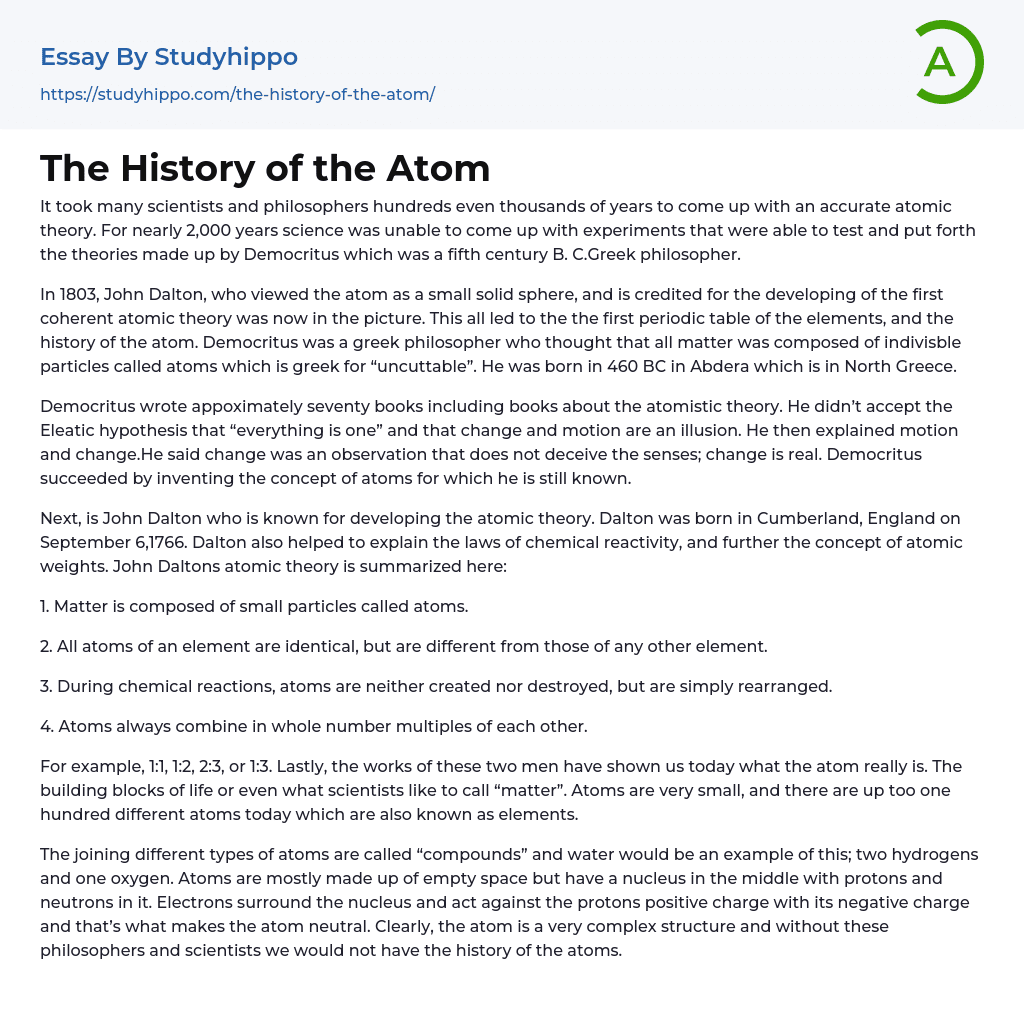Scientists and philosophers took many centuries to develop a precise atomic theory. Over a period of almost 2,000 years, there was a dearth of experiments conducted for verifying and endorsing the theories put forth by Democritus in the fifth century B.C.
C. Greek philosopher. In 1803, John Dalton, who saw the atom as a small solid sphere and is credited with developing the first coherent atomic theory, emerged. This ultimately resulted in the creation of the first periodic table of elements and shaped the history of the atom. Democritus, a Greek philosopher, believed that all matter consisted of uncuttable particles called atoms ("uncuttable" in Greek). He was born in Abdera, located in North Greece, in 460 BC.
Democritus, known for his approximately seventy books, including those on the atomistic theory, rejected the Eleatic hypothesis that suggests everything is one and that motion and ch
...ange are merely illusions. Instead, he argued that change is a genuine observation that does not deceive our senses. Democritus delved into explaining motion and change, ultimately inventing the concept of atoms, for which he remains renowned. John Dalton, in turn, made significant contributions by developing the atomic theory.
Dalton, born on September 6,1766 in Cumberland, England, contributed to the understanding of chemical reactivity laws and the concept of atomic weights. His atomic theory can be summarized as follows:
1. Matter consists of tiny particles known as atoms.
2.
All atoms of an element possess identical properties, yet they exhibit distinctions from atoms belonging to other elements. During chemical reactions, atoms undergo rearrangement rather than being created or annihilated.
Atoms combine in ratios that are whole number multiples of each other, such as 1:1, 1:2
2:3, or 1:3. Ultimately, the research conducted by these two individuals has unveiled the true nature of atoms - the basic building blocks of life and what scientists commonly call "matter".
Atoms, also called elements, are very tiny and there are currently approximately one hundred different kinds of atoms. When different types of atoms combine, they create "compounds," such as water with its two hydrogens and one oxygen. Despite being mainly empty space, atoms possess a nucleus at their center that holds protons and neutrons. Revolving around the nucleus are electrons which balance out the positive charge of the protons by carrying a negative charge, resulting in an atom that is neutral overall. The intricacy of the atom is evident and our comprehension of it has been greatly advanced by contributions made by philosophers and scientists throughout history.
- Russian Empire essays
- Ancient Greece essays
- British Empire essays
- Historical Figures essays
- Nazi Germany essays
- Roman Empire essays
- War essays
- Revolution essays
- 19Th Century essays
- Historiography essays
- History of the United States essays
- 20Th Century essays
- World History essays
- Vikings essays
- Declaration of Independence essays
- Civilization essays
- Evidence essays
- Genocide essays
- Colonialism essays
- Rebellion essays
- 1960S essays
- 1920S essays
- 1950S essays
- Letter from Birmingham Jail essays
- Louisiana Purchase essays
- The Columbian Exchange essays
- World Hunger essays
- What is History essays
- Bravery essays
- Gilded Age essays
- Vladimir Lenin essays
- Alexander The Great essays
- Sparta essays
- Victorian Era essays
- Henry v essays
- Stonehenge essays
- Frederick Douglass essays
- Mahatma Gandhi essays
- Joseph Stalin essays
- Geert Hofstede essays
- George Eliot essays
- Ginevra King essays
- John Keats essays
- Siegfried Sassoon essays
- Ben jonson essays
- Billy elliot essays
- Wilkie collins essays
- John Proctor essays
- Harriet Tubman essays
- Napoleon essays




